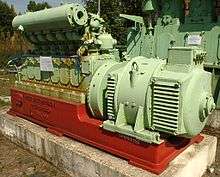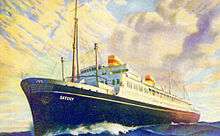MS Batory
M.S. Batory was an ocean liner of the Polish merchant fleet, named after Stefan Batory, the sixteenth-century king of Poland. She was the sister ship of the MS Piłsudski. Following wartime service for her country, mainly under the British Admiralty, she became in 1951 the pride of the Polish Ocean Lines and the Polish merchant fleet.
 MS Batory before World War 2 | |
| History | |
|---|---|
| Name: | M.S. Batory |
| Namesake: | King Stefan Batory |
| Owner: |
|
| Port of registry: | Gdynia, Poland |
| Ordered: | 29 November 1933 |
| Builder: | Cantieri Riuniti dell'Adriatico, Monfalcone |
| Yard number: | 1127 |
| Laid down: | 1 May 1934 |
| Launched: | 3 July 1935 |
| Acquired: | 23 April 1936 |
| In service: | 1936 |
| Out of service: | 2 June 1971 |
| Identification: |
|
| Nickname(s): | Lucky Ship |
| Fate: | Scrapped, 1971 |
| General characteristics | |
| Type: | ocean liner |
| Tonnage: | 14 287 GRT |
| Length: | 160.4 m (526.25 ft) |
| Beam: | 21.6 m (70.87 ft) |
| Draught: | 7.5 m (24.6 ft) |
| Decks: | 4 + 3 in superstructure |
| Installed power: | two Sulzer 2SSA 9-cylinder diesel engines, 12 680 hp (12 500 hp from April 1947) |
| Propulsion: | 2 screws |
| Speed: | 18 knots |
| Capacity: |
|
| Crew: |
|
History
Construction
The Gdynia America Line (Gdynia–Ameryka Linie Żeglugowe, GAL), a Polish-Danish partnership based in Gdynia, was formed in 1934 as successor to Polskie Transatlantyckie Towarzystwo Okrętowe (PTTO), an enterprise originally dedicated to transporting Polish migrants to the USA. It changed its focus to leisure travel and for that purpose decided to commission a new vessel. Batory was built in 1934-5 at the Cantieri Riuniti dell'Adriatico Monfalcone shipyard in Trieste, Italy, under an arrangement where part of the commission was paid in shipments of coal from Poland. She was among the most notable tourist attractions of the Polish coastline and among the best-known Polish ships of all time. The vessel was launched on 3 July 1935. She was powered by two Sulzer diesel engines driving two screws giving a speed of 18 knots. She began regular service in May 1936 on the Gdynia—New York run, and by 1939 had carried over 30,000 passengers.
World War II

Mobilized at the outbreak of World War II, she served as a troop transport and a hospital ship by the Allied Navy for the rest of the war. In 1940 she, along with MS Chrobry, transported allied troops to Norway. She was also used for secretly shipping many valuable Polish treasures to Canada for safekeeping. She participated in the evacuation of Dunkirk late May early June, taking aboard 2,500 persons. Later she carried as many as 6,000 people in one evacuation. In June to July, she secretly transported much of Britain's gold reserves (£40 million) from Greenock, Scotland to Montreal, Canada for safekeeping. On 4 August 1940 she left Liverpool with convoy WS 2 (Winston's Specials) evacuating 480 children to Sydney, Australia, under the Children's Overseas Reception Board until the war was over. She sailed via Cape Town, India, Singapore to where she had carried 300 troops and Sydney. The journey had been a happy one, with so much music and laughter that the Batory was dubbed the "Singing Ship" and was the subject of a book of the same name.[1] In April 1942 British writer Roald Dahl was on board to America.
She was involved in the allied invasion of Oran, Algeria in 1942. That same year she transported troops to India and participated in the occupation of Sicily and southern France, where she was the flagship of General Jean de Lattre de Tassigny, Commander-in-Chief of the French Army. She came under attack several times from the ground and the air, but managed to escape serious damage.
Dubbed the Lucky Ship for her military career during World War II, she was a sister ship to the less fortunate MS Piłsudski which sank in November 1939 off the East coast of Scotland.
Postwar career
Returned to "liberated" Communist Poland in 1946, she resumed civilian service after a refit, transporting such eminent people as Ryszard Kapuściński. From May 1949 through to January 1951, she was the subject of several political incidents in which American dockers and shipyard workers in the United States refused to unload her cargo, or to service the ship.
After these incidents, she was withdrawn from the North Atlantic route, refurbished at Hebburn for service in the tropics, and sailed in August 1951 from Gdynia and Southampton to Bombay and Karachi, via Gibraltar, Malta, Aden, and Suez. In 1957, she returned to the North Atlantic run. She continued in service until 1971, when she was decommissioned in Hong Kong.
She was replaced by a larger vessel, the TSS Stefan Batory, which operated from April 1969 till 1988.
Gallery
 M.S. Batory in Gdynia, 1937
M.S. Batory in Gdynia, 1937 M.S. Batory arriving in New York City
M.S. Batory arriving in New York City The vessel in 1962
The vessel in 1962 Unloading in Gdynia wharf, 1960s
Unloading in Gdynia wharf, 1960s_10.jpg) A smaller scale model of M.S. Batory in Gdynia, 2007
A smaller scale model of M.S. Batory in Gdynia, 2007 One of the engines of the ship, taken out before scrapping
One of the engines of the ship, taken out before scrapping M.S. Batory postcard
M.S. Batory postcard
References
- The singing ship: an odyssey of evacuee children, Meta Maclean, Angus and Robertson, Sydney. 1941
- ts/s Stefan Batory. (1971). Polish Ocean Lines, Gdynia, Poland.
- Cruising Ships, W.H. Mitchell and L. A. Sawyer, Doubleday, 1967
Further reading
- Swoger, Gordon (2004). The Strange Odyssey of Poland's National Treasures, 1939-1961: A Polish-Canadian Story. Dundurn Press.
External links
- Peter Wieslaw Grajda: M/S BATORY, the Polish Ocean Liner - History & Photographs
- History of M/S Pilsudski and M/S Batory
- A photo of MS Batory at Suez Canal Zone 1953
- M/S Batory, the Polish Ocean Liner - History & Photographs
| Wikimedia Commons has media related to Batory (ship, 1936). |